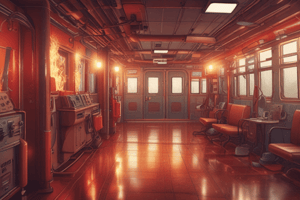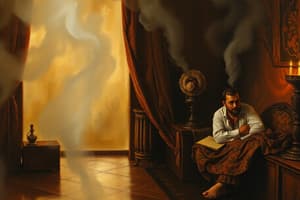Podcast
Questions and Answers
What is the primary action the Fire Department must take if a carbon monoxide problem is suspected?
What is the primary action the Fire Department must take if a carbon monoxide problem is suspected?
- Conduct a thorough inspection without evacuating occupants.
- Deactivate all carbon monoxide detectors in the area.
- Immediately evacuate the structure and call for a medic if symptoms are present. (correct)
- Wait for an external agency to evaluate the situation.
Which type of instrument is essential for detecting carbon monoxide issues?
Which type of instrument is essential for detecting carbon monoxide issues?
- Standard thermometer
- Standard smoke alarm
- Ultrasonic leak detector
- Multi-gas instrument (correct)
What critical information must Fire Department personnel keep in mind regarding carbon monoxide detectors?
What critical information must Fire Department personnel keep in mind regarding carbon monoxide detectors?
- They should be removed from all homes for safety.
- They are allowed to deactivate them in case of false alarms.
- CO detectors must only be serviced by professionals.
- Occupants should check them according to the manufacturer's guidelines. (correct)
Where should testing for carbon monoxide be focused during an investigation?
Where should testing for carbon monoxide be focused during an investigation?
Which statement about carbon monoxide is FALSE?
Which statement about carbon monoxide is FALSE?
What should be the first step taken when responding to a suspected carbon monoxide emergency?
What should be the first step taken when responding to a suspected carbon monoxide emergency?
What must be ensured before using the CO monitoring instruments?
What must be ensured before using the CO monitoring instruments?
If individuals exhibit symptoms of carbon monoxide poisoning, what is the immediate requirement?
If individuals exhibit symptoms of carbon monoxide poisoning, what is the immediate requirement?
Who is primarily responsible for determining if a Carbon Monoxide (CO) problem exists?
Who is primarily responsible for determining if a Carbon Monoxide (CO) problem exists?
What should be done to ensure the proper functioning of the CO monitor?
What should be done to ensure the proper functioning of the CO monitor?
Where should outside air samples be taken when assessing CO levels?
Where should outside air samples be taken when assessing CO levels?
What is the first step to take when occupants exhibit symptoms of CO poisoning?
What is the first step to take when occupants exhibit symptoms of CO poisoning?
What should be done if the oxygen (O2) content inside a structure is found to be below 19.5%?
What should be done if the oxygen (O2) content inside a structure is found to be below 19.5%?
Which symptom may indicate carbon monoxide poisoning?
Which symptom may indicate carbon monoxide poisoning?
What is the minimum requirement for any monitoring instrument used to assess CO levels?
What is the minimum requirement for any monitoring instrument used to assess CO levels?
Which of the following is NOT a responsibility outlined in the CO monitoring guidelines?
Which of the following is NOT a responsibility outlined in the CO monitoring guidelines?
What should be inspected first when checking a furnace for proper operation?
What should be inspected first when checking a furnace for proper operation?
What is the appropriate action if CO readings indicate a presence of CO above 10 ppm in a residential structure?
What is the appropriate action if CO readings indicate a presence of CO above 10 ppm in a residential structure?
When checking a gas water heater, what should be done to obtain readings?
When checking a gas water heater, what should be done to obtain readings?
In which instance should the gas for a gas-log fireplace be shut off?
In which instance should the gas for a gas-log fireplace be shut off?
What is one common improper condition that should be avoided?
What is one common improper condition that should be avoided?
What action must be taken with all readings obtained during inspections?
What action must be taken with all readings obtained during inspections?
What should be checked regarding the flue of a gas clothes dryer?
What should be checked regarding the flue of a gas clothes dryer?
Where should the meter be held when inspecting a fireplace?
Where should the meter be held when inspecting a fireplace?
What is the recommended action if the source of Carbon Monoxide (CO) can be easily identified?
What is the recommended action if the source of Carbon Monoxide (CO) can be easily identified?
Which of the following statements is true regarding Carbon Monoxide (CO)?
Which of the following statements is true regarding Carbon Monoxide (CO)?
What is stated about CO detectors owned by homeowners?
What is stated about CO detectors owned by homeowners?
What can be inferred about the nature of CO sources?
What can be inferred about the nature of CO sources?
Which of the following is NOT a characteristic of Carbon Monoxide (CO)?
Which of the following is NOT a characteristic of Carbon Monoxide (CO)?
How often are CO detectors recommended to be checked?
How often are CO detectors recommended to be checked?
What should be done first in the event of a known CO leak in a residence?
What should be done first in the event of a known CO leak in a residence?
Who is responsible for ensuring that CO detectors are working properly?
Who is responsible for ensuring that CO detectors are working properly?
What is the effective date of the Carbon Monoxide Monitoring policy?
What is the effective date of the Carbon Monoxide Monitoring policy?
Which office is primarily responsible for questions on the policy?
Which office is primarily responsible for questions on the policy?
Who approved the Carbon Monoxide Monitoring policy?
Who approved the Carbon Monoxide Monitoring policy?
Which of the following is NOT mentioned in the references and related policies section?
Which of the following is NOT mentioned in the references and related policies section?
What is the review date for the Carbon Monoxide Monitoring policy?
What is the review date for the Carbon Monoxide Monitoring policy?
According to the document, what characteristic does this policy possess regarding legal duties?
According to the document, what characteristic does this policy possess regarding legal duties?
How will the public be able to submit errors or inconsistencies in the document?
How will the public be able to submit errors or inconsistencies in the document?
Which of the following roles is the highest rank mentioned under the contact office?
Which of the following roles is the highest rank mentioned under the contact office?
Flashcards are hidden until you start studying
Study Notes
Carbon Monoxide Monitoring
- The Fire Department is responsible for determining if a CO problem exists and ensuring emergency medical care is provided if needed.
- The CO monitor should be checked to be sure it is working and the appropriate multi-gas instrument should be selected.
- The instrument should be tested in fresh air before use to ensure proper functioning.
- When responding to a suspected CO incident, the structure should be evacuated immediately.
- If any occupants display symptoms of CO poisoning, a medic unit should be called immediately.
- The oxygen (O2) content inside the structure should be tested before entry. If it is below 19.5%, an SCBA must be utilized by all personnel entering the structure.
- Areas related to the suspected source of CO, such as gas-fired appliances, furnaces, boilers, and space heaters should be checked for CO levels.
- Gas-fired appliances should be checked to ensure the flue is connected, unobstructed, and drafting.
- CO detectors in residence should be checked as per the manufacturer's recommendations.
- No Fire Department personnel should disconnect or deactivate any CO detector owned by the homeowner.
- Carbon Monoxide (CO) is an odorless, tasteless, colorless gas that is deadly and can cause symptoms that can mimic the flu and proceed to unconsciousness and even death.
- Many appliances around the home can produce Carbon Monoxide when a fault or unusual condition exists.
- If the source of the CO can be easily identified, the fuel supply should be shut off and the building should be ventilated as necessary.
- If CO readings indicate CO present, possible sources of CO should be investigated and the gas company should be notified if readings are above 10 ppm in residential structures, and above 35 ppm in commercial or industrial structures.
- All readings taken and their location in the structure should be documented and included in all applicable reports.
- If high CO readings are obtained, it is possible that a LEL (lower explosive limit) reading may also be obtained.
Safety Precautions
- When operating in an environment with a high risk of CO exposure it is recommended to use a multi-gas monitor.
- Multi-gas monitors should be able to measure at a minimum both O2 and CO.
- It is important to test your monitor in a fresh-air environment and ensure it passes all its self-testing before using it.
- Personnel entering structures with CO present can utilize an SCBA to protect themselves from CO exposure.
Studying That Suits You
Use AI to generate personalized quizzes and flashcards to suit your learning preferences.




